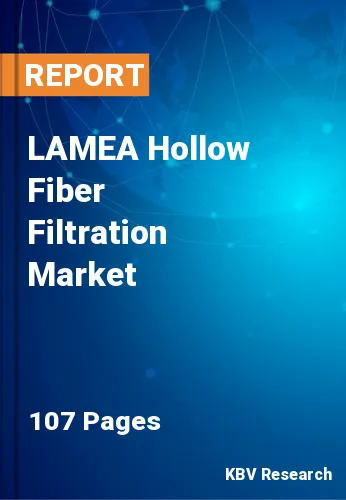The Latin America, Middle East and Africa Hollow Fiber Filtration Market would witness market growth of 20.2% CAGR during the forecast period (2022-2028).
Inserted within sturdy, pressurized vessels that are each organized on a modular skid are hollow fiber membranes. Depending on the liquid, the application, and the expected quality of the filtrate, the system can then be run in one of two ways.
Without recirculation or concentrate removal, the complete feed flow is sent to the hollow fiber membrane in a dead-end operation. The membrane's surface is coated with the suspended solids from the feed flow, creating a cake layer that begins to function as a filter on its own.
Dead-end filtering lessens the need for pumping because there is no need to recirculate retentate, thus lowering the amount of operational energy required. For liquids with smaller particle loads, dead-end filtering is frequently utilized. High surface area membranes can be utilized to maintain low flux rates and enable the filtration cake to develop on the surface for higher particle loads.
The decrease of the kidney's capacity to keep the body's electrolyte balance stable and eliminate metabolic waste products is known as renal insufficiency. If correctly managed, the disease's acute phase causes a rapid decline in renal function that can be reversed. Contrary to acute renal insufficiency although, chronic renal insufficiency is defined by the progressive and irreversible loss of such functions. As per the Brazilian Nephrology Census conducted in July 2016, 122,825 Brazilians are receiving dialysis due to renal insufficiency.
The Brazil market dominated the LAMEA Hollow Fiber Filtration Market by Country in 2021, and would continue to be a dominant market till 2028; thereby, achieving a market value of $30.6 Million by 2028. The Argentina market is experiencing a CAGR of 20.9% during (2022 - 2028). Additionally, The UAE market would display a CAGR of 19.9% during (2022 - 2028).
Based on Application, the market is segmented into Protein Concentration & Diafiltration, Cell Culture Harvest & Clarification, Virus or Viral Vector Filtration, Raw Material Filtration, and Others. Based on End User, the market is segmented into Pharmaceutical & Biotechnology Companies, CMOs & CROs, and Academic & Research Institutes. Based on Technology, the market is segmented into Microfiltration, Ultrafiltration, and Others. Based on Process, the market is segmented into Reusable and Single-use. Based on Material, the market is segmented into Polyethersulfone (PES), Polysulfone (PS), Mixed Cellulose Ester, Polyvinylidene Difluoride (PVDF), and Others. Based on countries, the market is segmented into Brazil, Argentina, UAE, Saudi Arabia, South Africa, Nigeria, and Rest of LAMEA.
Free Valuable Insights: The Global Hollow Fiber Filtration Market is Predict to reach $1.4 Billion by 2028, at a CAGR of 13.7%
The market research report covers the analysis of key stake holders of the market. Key companies profiled in the report include Repligen Corporation, Sartorius AG, Asahi Kasei Corporation, Meissner Filtration Products, Inc., Danaher Corporation, Merck KGaA, Parker Hannifin Corporation, Cole-Parmer Instrument Company, LLC (Antylia Scientific) (GTCR LLC), Sterlitech Corporation, and Synder Filtration, Inc.
By Application
By End User
By Technology
By Process
By Material
By Country
Our team of dedicated experts can provide you with attractive expansion opportunities for your business.

